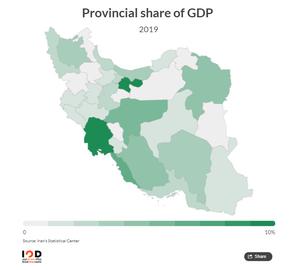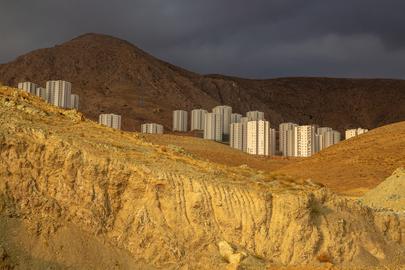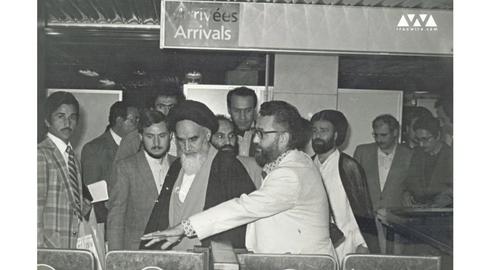Glaring disparities in regional wealth, local government spending and average incomes have been revealed in data published by the Statistical Center of Iran (SCI).

Regional share of GDP shows the total value of goods and services produced within a province. It indicates how wealth is geographically distributed across Iran. In 2019, more than half of Iran’s GDP was concentrated in just five provinces. With the large number of government offices and private businesses in the capital, Tehran unsurprisingly brought in the highest share of GDP of all the country’s 31 provinces at 22%. The oil-rich but otherwise deprived province of Khuzestan ranked second.
Dr Kian Tajbakhsh of Columbia University, a long-time scholar of local government in Iran, said these findings alone should be taken with a pinch of salt as “as oil distorts the picture … If you take out oil, Khuzestan is one of the poorest provinces because everything else is not developed. The big GDP coming out of Khuzestan does not belong to Khuzestan. As far as central government is concerned, it does not belong to them.”
Bushehr, just south of Khuzestan, ranked third – probably due to its large energy industry. In October 2021, the head of Iran’s Atomic Energy Agency, Mohammad Eslami, announced that Russia would be resuming work to expand the nuclear power plant after a 22-month hiatus.
Provincial budgets show how much money is allocated by Iran’s central government to the municipalities. In 2021, Qom received the lowest share of the provincial budget at around 696 billion tomans (US$25,000,000). But again, as Iran Open Data pointed out, this does not provide a clear picture by itself. For a more meaningful comparison of provincial budgets, it is vital to consider population and adjust the figures on a per capita basis.
Doing so, Tehran replaces Qom at the bottom of the list, despite the fact that that province contributes the most to the public purse. Dr Tajbakhsh explained: “Being the richest province, Tehran has a lot of locally-generated revenue, so it receives less direct government support. It’s not necessary.” However, he pointed to massive shortfalls in funding for public transport in Tehran: “The central government keeps promising Tehran they’re going to help them pay for the system, but they don’t give them any money. Mostly because they keep running into massive budget deficits.”
‘Invest it All in Oil’
Another striking feature of the above map is that Khuzestan receives one of the highest shares of Iran’s national budget: more than 4.8 trillion tomans in 2021. But this massive spend on Khuzestan does not translate into prosperity for its people. The province suffers from the highest absolute poverty rate in Iran and is high on the country-wide misery index.
Dr Kian explained that this was because most of the central government funding was for extracting oil and gas. “Much of that money has been spent on building oil infrastructure … the provincial budget is not necessarily going into cash support for families or services.” He suggested that expenditure on oil could be diverting much needed funding away from other areas, such as health care and education.
“There is a rumour that the government has held back from broader development of Khuzestan and neighbouring provinces because... they fear that if there were a conflict, and the area experienced destruction like it did during Iran-Iraq war, it would be a waste of resources to invest in these areas.” He stressed that for now at least, this has not been corroborated by any direct evidence or specific policy programs.
All this aside, when the share of Iran’s national budget is calculated per capita, Ilam province replaces Khuzestan at the top of the list. In the past few years, this expenditure has accompanied a surge in oil output in the province, with the Iranian government announcing in 2020 that there are plans underway to boost production even further.
Average income of urban households is one potential indicator of the standard of living and quality of life. It represents how much a typical household earned in each of Iran’s provinces in 2019. What this metric reflects, Dr Tajbakhsh explains, is people’s access to jobs, central and local government spending, higher education qualifications and how concentrated economic activity is in the cities.
Data from a 2019 report by the SCI shows that in Khuzestan and Bushehr the average household income was about 13% lower than the national average. A partial reason for this is that Khuzestan’s oil industry has not created employment opportunities for local people: many of the skilled specialists and engineers working in the province are brought in from elsewhere in the country. Most of the jobs created locally are low-level construction and ancillary services roles, which do not pay very much.
Even with the petrochemical industry, Khuzestan’s unemployment rate is 45 percent higher than the national average. The rate is similarly high in Bushehr.
Data published by the SCI in 2009 revealed that 70 percent of Khuzestan’s GDP comes from the petrochemical industry. A better way of explaining regional inequality in Iran, Dr. Tajbakhsh said, is human capital: the proportion of the population who are university graduates or have gone to high school. The more educated a province, the wealthier it will be.
Related coverage:
Iran's Western Provinces Ranked Most 'Miserable' in the Country
Measuring Discontent in Iran's Khuzestan Province
One Hour of Running Water a Day for Residents of Oil-Rich Khuzestan
Iran's Local Government Stitch-Up, and How to Resolve It
Number Crunching: The Truth Behind Iran's 'Single-Digit' Unemployment Rate
visit the accountability section
In this section of Iran Wire, you can contact the officials and launch your campaign for various problems

























comments